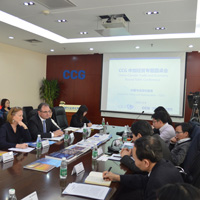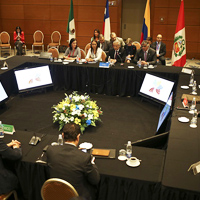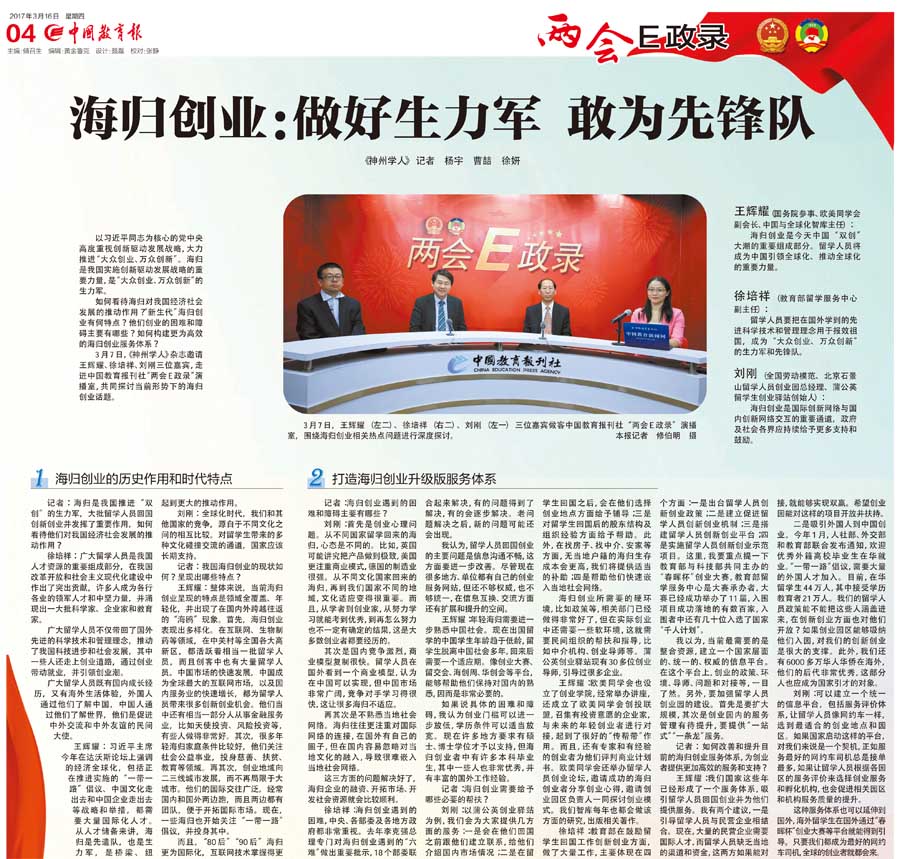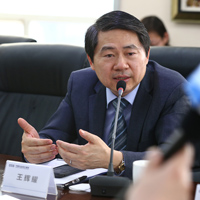-

【中国贸易报】中加贸易合作潜力有待挖掘
贸易往来在中加两国关系中扮演着重要角色。上世纪60年代,加拿大打破西方国家对中国的贸易封锁,率先对华出口小麦,叩开了中加关系大门,如今,中加经贸再度升温。在近日由中国与全球化智库(CCG)和加拿大国际治理创新中心(CIGI)共同举办的中加经贸专题圆桌会上,中加双方学者、官员就双边合作机遇、中加贸易走向,以及大家较为关注的TPP和中加自贸协定等问题展开了深入研讨。与会者对中加两国长期以来的良好政治、经济关系给予了肯定,同时也对未来两国经贸合作提出了可行性建议。两国经贸合作潜力大 IGI高级研究员、加拿大渥太华大学公共国际事务研究生院副院长Patrick Leblond认为,在贸易保护主义形势下,加拿大会继续在经济和政治方面坚持开放的心态和全球视野。“TPP虽然受到各方关注,但前景却不明朗,特朗普政府目前看来更倾向于分别通过与加拿大和墨西哥的双边谈判来建立新的贸易机制。另一方面,加拿大也将简化与欧洲各国的贸易和投资渠道,并促进和亚洲国家如中国和日本的贸易往来。”Patrick Leblond表示,中加贸易机会和挑战并存,需要以两国之间的沟通和交流作为基础,而加拿大与欧盟间的贸易协定可以为中加未来谈判提供很好的借鉴。 记者了解到,截至2016年底,中加双边贸易额从建交初期的1.56亿美元跃升至近456亿美元,增长了近300倍。但事实上,中加贸易额只占中国外贸总额约1.1%,占加外贸总额约7.2%,这与中国作为世界第二大经济体和全球第一大贸易国,加拿大为西方主要经济体之一的两国地位相比,还略有不符。(记者 张伟伦)文章选自《中国贸易报》,2017年3月14日
2017年3月20日 -
CCG资深副主席曹德旺:降低税负水平 控制要素成本
理事简介曹德旺,全国政协委员,中国与全球化智库(CCG)资深副主席,福耀集团董事长。 2017年3月12日,清华大学中国与世界经济论坛(三十一)——“实干兴邦”在清华大学举办。本次论坛由清华大学中国与世界经济研究中心、清华大学经济管理学院校友发展中心主办,凤凰国际智库提供媒体支持。论坛就当前中国经济存在的房地产症结、美国加息带来的资本外流压力等等问题展开讨论,就当前经济形势和热点话题分析问题的脉络,提出相应的战略选择与政策建议,积极寻求“实干兴邦”的策略构想。中国民营经济税负水平:太高了 有一次我参加中美一个企业论坛,美中商会的会长提到中国政府对美国不友好,他说有两个方面,第一个是税,我们进来投资的时候有很多的优惠政策,现在没有了。第二,他说电子产品跟互联网落地的门槛不断提高,阻止我们进去。 我跟他们说,我跟你交的是一样的税,这个事情我已经注意很久了,很多人跟我反映这个事情,我当政协委员也经常去找企业界去论证这个事情,确实有这样的问题,不是只对你,是对中国所有企业。今天贾康先生来,我想当场请教一下,祖宗创这个“税”字,是禾和兑,但是几千年演变过来,这个字变成了管理国家两个可用的工具(货币和财政)之一,而且是财政里面的重头之税。所有的设计有两个根本必须保证,第一保证民本,跟老百姓生活相关的必需品可以考虑低税或者是免税。十几年来,现在我的工人收入涨到了8千元,起征点还是3500元,不是他在交,而是企业在交,因为打工者赚了钱不够吃饭,他就会走。伤到民本,是不可行的。第二不能伤到资本。美国人提的意见,我听完了以后,发现我们的税负太高了,我所提的不仅仅是税,我提的是环境要素成本,从人工、材料、能源、税费等一系列的东西比较。中国经济增长目标过高,不利于控制要素成本 这次两会期间我很感动,财政部组织相关部门,召集开了两次会,来了一大批人,我们跟他们详细报告要素成本控制的关键。2015年在香港发H股的时候,接待了一个美国来的大银行的董事长,他考我,说曹总,中国经济调到6.5%增长,你怎么看这个事情。我跟他讲,太高了。他说你是我见到第一个中国人的话。我跟他讲你承认自己是不是美国前五大的银行,他承认,他这一方面的知识肯定比我高。我请教他,过去的30年美国GDP增长是多少,他答不上来,我说大概加起来平均没有超过3%。我问他,你知道美国黑人人口有多少?我说20年前我到美国,不到两亿,过去30年美国人口平均增长率是3.5%, 3.5%的人口增长率只有3%不到GDP的增长,中国为什么要6.5%的增长?现在不是过去的中国了。什么国家能保持两位数的GDP增长,只有朝鲜,如果他改革开放马上就是两位数,朝鲜什么都没有,基数很低,我们现在基数这么大,不可能要求这么高。目标定得太高,劳工、资本、材料、资源这些就会上涨。请大家要注意到中国是中国人的中国,保卫中国,发展中国,建设中国,是每个中国人的责任,更是每个精英的责任,不要整天瞎说,一切都是为了国家进步和繁荣。给小微企业免税 我跟总理建议,今年再拿3500亿出来。我去年最后净利润实际上接近40亿,拿去美国投资的时候,冲掉之后剩下了税收利润31亿多,国家交税交了21亿多。为了国家的进步,要去培养小微企业,小微企业让银行去救助是错的,银行都不给他贷款的,因为他需要五个必备,他都没有,亏本了没有人负担。所以就把这些财政税收拿去给小微企业,直接免税,不要减税,减税还有税警去找他,税警如果水平不高,还要叫他请吃饭,还要塞红包,现在把税收免了,这个问题就解决了。 当然,这个事情总理怎么决定我不知道。我相信他会去做很多的事情,我是站在这里,他是在屋顶,他站的角度不一样,考虑的问题也不一样。特朗普缺的不是钱,是人 美国的记者采访我,问特朗普的关税45%,你怕不怕?我说不怕,特朗普是美国人选的总统,每一秒钟大脑里面神经转动的都是美国利益最大化,他如果不是这样的,不配当总统,我也不敬重他,作为中国人我非常敬重他这种人的理念。我仔细研究美国人需要什么、他需要的东西会不会做。如果你又需要,又不会做,肯定必须上外面买,我做得好,就利用这个机会卖给你。 特朗普不是缺钱,是缺人。我在那边办工厂的时候,我能够招到的工人都是比我大,胡子也比我长,在八十年代去工业化的时候,不管哪个学校出来的大学毕业生,整个往硅谷跑,往华尔街跑,往好莱坞跑,八十年代没有人去底特律。到现在已经40多年了,没有人干活了,基础设施落后到跟中国不能比,无论是铁路还是公路。现在说拿几万亿,我说钱肯定没有问题,就是缺人,拿不出来。 但中国不会有劳动力支持他做这个,他连墨西哥都不需要。那天记者跟我讲,工作是不是被中国人抢了?华尔街那边的工作肯定是被中国人抢了,因为20年前我看人家上市都是华尔街机构做的,现在中国做得比你还好。华尔街的人员减少是事实的,制造业没有拿你的,我们出口量还在下降,不会拿他的。做有良心的工业企业 福耀现在是全球最大的汽车玻璃厂,陆虎、宾利宝马和奥迪都是我的客户,中国市场70%多是我供货的。什么叫品牌?这里边包括四个品。第一,要有人品,有一个正确的追求,有良好的愿景,这是必备的。第二,必须有国家需要,社会需要,人民需要的产品。我当初创业的时候,中国人没有玻璃,我是跟日本人打,后来我做维修市场,维修市场跟他们抢了,我就去做配套市场,他们想冲上来,我说拿到国际市场跟你们拼,后来跟美国打赢了以后,把我评为第一个供应商。所以第二个是产品,我做汽车玻璃,早期服务你们,后期服务汽车厂,要研究他们的特色,同步设计,自主品牌。去年中科院在福耀定点,我们是工业4.0的示范单位,因为我们自动化的程度很高。我们还有一段后端智能化管理和智能化生产要跟上去,最坚决地完成国家下达的任务。 第三个就是品质,企业不一定要做到这么大,起码要稳定。做稳定很难,必须标准化,程序化做,才能稳定。第四个是品位,要有能够经得起推敲,经得起人家的评价的品味。因此我很自豪的说,我到全球汽车厂,他们的老板肯定见我,跟我见面,请我吃饭。 很多人看到,房地产好赚钱,互联网好赚钱,PE、VC基金好赚钱,全部往那里跑。我再次呼吁他们要注意,美国奥巴马总统提出来恢复制造业大国,我们也要去抓这个事情。这些土豪看到中国没有这么好的东西,只能去外面买,中国做的产品卖给中国人,有需要的人没有钱,有钱的人不买你的,去国外旅游,顺便带一点回去,跟邻居说我的日本马桶盖是日本的,好听一点。有钱的人跑到国外去消费,没有钱的人在中国再便宜他也不要,我们死就死在这里。我跟你们年轻人讲,我没有参与决策,但是我是企业家,我也不知道是谁的责任,不要讨论这个事情,去做就行了。 如果有人给你投资,能不能做出中国愿意买的马桶盖、电饭煲? 所有企业缺钱,我不缺钱,我的户头存款10亿美金。不是随便投钱就可以转行的,我只能在玻璃上打转,要我做发动机,我也不行,毛先生叫我去做房地产,我也不行。因此我这次在政协的建议里面,恢复制造业的时候,要把国企改革结合进来,利用好它的产业优势,还有人才的优势。 最后,大家分别用一句话来概括自己最想给两会提的建议,曹德旺先生提出,供给侧改革要从控制要素成本上抓起来。文章选自凤凰国际智库,2017年3月14日
2017年3月20日 -

【Bloomberg BNA】China to Tout Role in TPP, Japan Eyes Range of Scenarios
Representatives from 15 nations are gathering in Chile March 14-15 to plot a new course for regional trade, and many are scouting out the opportunities for advancing multilateral trade deals at a time when protectionism is on the rise.At the top of many countries’ agenda is talk of how to integrate the trade and economies of the Asia-Pacific region. Many still see the Trans-Pacific Partnership as a possibility in some form, even as a template for other agreements. But should that not come to pass, the seven members that are in both the TPP and the Regional Comprehensive Economic Partnership could move ahead by pushing RCEP, they said.But the items on countries’ individual wish lists are varied, and in some cases telling. China, for one, will probably present itself as a replacement for the U.S. in the TPP, analysts and state media have said. That’s in keeping with the country’s increasingly global stance, evident in President Xi Jinping’s remarks at the World Economic Forum in Davos, Switzerland.Other countries, specifically Japan, are saying not so fast. There are a range of scenarios to consider with what happens to the TPP — both with and without the U.S., one Japanese official said. And there is always the concern that China will become dominant in such a plurilateral pact, the official said.Still others are taking a wait-and-see stance toward the talks, dubbed the High-Level Dialogue on Integration Initiatives in the Asia-Pacific Region.New Zealand’s trade minister Todd McClay, for example, noted that the Chile talks would mark the first meeting of all the remaining 11 TPP signatories since President Donald Trump withdrew the U.S. from the 12-nation pact.U.S. RoleAnd what about the U.S.? Well, the country has been invited to attend the two-day meeting and has even accepted. But there hasn’t been any official confirmation from Washington on who will represent the U.S., so the job is likely to fall to Carol Perez, U.S. ambassador to Chile since September, suggesting the U.S. will play a more passive role.China Replacement for U.S.?China is likely to advance its potential as a replacement for the U.S. in the TPP during the summit, analysts said. Beijing is keen to promote its influence on world trade to combat what it views as an increasingly hostile international trade environment, and it sees the TPP as an opportunity to do this.Still, the Chinese government characterized the meeting as an exchange of views about the Asia-Pacific region, not a TPP summit.“This meeting is a high-level meeting of the Pacific Alliance and Asia-Pacific countries on Asia-Pacific economic integration, where extensive exchange of views will be conducted on the next step of Asia-Pacific regional cooperation,” Foreign Ministry spokeswoman Hua Chunying said March 13 at the ministry’s regular media briefing. “It is not a TPP meeting, as is described by some media. China hopes this meeting will contribute to the [Free Trade Area of the Asia Pacific (FTAAP)] process, the open Asia-Pacific economy and Asia-Pacific regional economic integration.”The government is sending Ambassador Yin Hengmin, special representative for Latin American Affairs, to the summit, Hua Chunying said.But state media, which is normally a good barometer of government direction, and think tanks with connections to the authorities have spoken positively about China’s potential in the TPP in recent weeks.A Global Times editorial on Feb. 16, written by Wang Huiyao, a counselor to the State Council, described the U.S. exit from the TPP as an “opportunity” for China and said that joining the trade deal “could serve as crucial economic leverage.”According to a report released last month by the Center for China and Globalization, the country might want to seize an opportunity to “fill the position vacated by the United States at the TPP table.”Japan, Canada Up GameVice Economy and Finance Minister Takao Ochi will represent Japan during the two-day summit, a government official told Bloomberg BNA March 9. In addition, the Ministry of Economy, Trade and Industry is sending Toshinao Nakagawa, vice parliamentary minister, to Chile.The delegates are an upgrade from the earlier plan to dispatch senior administrative officials from the Ministry of Foreign Affairs, the Ministry of Economy, Trade and Industry and the Cabinet Office, but none at the ministerial level. Asked to explain the change, the official said the TPP’s importance as a pillar of the Asia-Pacific region’s trade platform would remain intact in the long run.Some have speculated that the new delegates were appointed partly in response to the dispatch of Canada’s trade minister and other high-ranking officials to the meeting, which may overlap with other regional trade framework meetings including RCEP.Canadian International Trade Minister Francois-Philippe Champagne will represent Canada at the meeting, spokeswoman Chantal Gagnon said March 8. The Canadian delegation’s focus will include supporting greater trade liberalization throughout the Asia-Pacific region, Gagnon told Bloomberg BNA in an email.Champagne will be accompanied by Steve Verheul, Global Affairs Canada’s chief trade negotiator for the Canada-European Union free trade deal, and Christopher Berzins, the department’s director of policy, Joseph Pickerill, the trade minister’s director of communications, told Bloomberg BNA.Pros, Cons of China in TPPThe Japanese official told Bloomberg BNA that there are a number of scenarios to be considered at the meeting.“We need map out a wide array of assumptions ranging from one that TPP enters into force without the United States participation; another that keeps the U.S. seat vacant but always welcomes whenever the United States reconsiders its no-TPP position; and more scenarios, including annexing RCEP to TPP and admitting China and India and Korea,” said the official, who spoke on condition of anonymity.Japan also will argue for the Asia-Pacific Economic Cooperation (APEC) forum’s relationship and engagement with TPP, he said. While Trump pulled the U.S. out of the TPP, he didn’t end the country’s participation in APEC, he noted.But Japan also will stake out its position on China becoming a part of the TPP, the official said. Specifically, Japan plans to discuss with other TPP countries the merits and drawbacks of China’s participation in the pact, as well as the pros and cons of annexing the RCEP regime.South Korea: Scope Out AtmosphereSouth Korean Deputy Minister for Trade Negotiations Lee Sang-jin will be the country’s delegate to the TPP talks in Chile, he told Bloomberg BNA.As Korea isn’t a member of the TPP talks, the country’s chief trade negotiator will attend to scope out the atmosphere among the remaining members following the U.S. withdrawal from the 12-nation trade pact.Korea declared interest in joining the TPP in 2013, since it was the most high-level and modernized multilateral trade negotiation on offer. But Korea never fully committed, and it hasn’t taken a new stance since the U.S. withdrew from the TPP in January.“There’s no agreement yet, so it’s very difficult to have some predictions on the future of the TPP,” Lee told Bloomberg BNA March 10. “First, I have to identify what’s going on. Then, depending on the situation and decisions by the TPP members, I will determine the position or how to proceed.”Korea has yet to re-evaluate the effects of joining the partnership without U.S. membership, another official who spoke on the condition of anonymity told Bloomberg BNA.Mexico: Searching for PartnersEconomy Minister Ildefonso Guajardo will lead the Mexican delegation for the meeting, as it aggressively looks for additional trade partners in the face of a possible renegotiation of the North American Free Trade Agreement.Following the U.S. election, the Mexican government said that it is looking at a range of options to take the place of the 12-country TPP agreement. In January, President Pena Nieto said Mexico would pursue bilateral agreements with TPP members New Zealand, Australia, Brunei, Malaysia, Singapore and Vietnam.Mexican trade officials also are proposing to extend membership in the Pacific Alliance to other TPP members, according to Guajardo, who has said the Pacific Alliance plans to meet in March and has invited the other TPP members. Trade opportunities with China and South Korea are also being assessed, according to several former trade officials.The TPP meetings are expected to be less politically contentious for Mexico than the NAFTA negotiations, where Foreign Minister Luis Videgaray, who is new to trade negotiations, is said to be taking the lead. That is despite Guajardo’s extensive negotiating experience in Mexico’s 40-plus trade agreements and participation in the first NAFTA agreement.Peru: Build on Pacific AlliancePeru’s government also sees the existing trading bloc in Latin America as the best option for strengthening trade ties with the Asia-Pacific region.Peruvian President Pedro Kuczynski told foreign reporters March 10 that Peru would push for a stronger Pacific Alliance, which also includes Chile, Colombia and Mexico, at the meeting.Kuczynski said the meeting shouldn’t be considered a TPP-plus meeting, but an opportunity to look at different ways to boost trade in the region. He said Peru was going to the meeting with the idea of strengthening the Pacific Alliance, formally in place since 2012, and using it as a way to establish new relations with Asia. Trade Minister Eduardo Ferreyros and Deputy Foreign Minster Nestor Popolizio will represent Peru at the meeting.“We want to explore the possibility of agreements as a group,” Kuczynski said.He said one option would be linking up the Pacific Alliance with the 10-nation Association of Southeast Asian Nations (ASEAN).Kuczynski’s comment echoed a statement from the four Pacific Alliance presidents after a teleconference earlier the same day. The presidents stressed the “decision for the Pacific Alliance to be a platform for a union between Latin America and Asia under the format of strategic integration based on free trade.”Singapore: TPP Still ‘Significant.’Singapore expects “constructive discussions” in Chile on the TPP, a trade spokesman told Bloomberg BNA, signaling the micro-state’s interest in keeping a seat at the table of a trade deal that’s still “significant” after the U.S. exit.Minister of State for Trade and Industry Koh Poh Koon will lead Singapore’s delegation at the summit, according to the Ministry of Trade & Industry. Previously the ministry said the TPP’s 11 remaining members have three options: continue TPP efforts with an option for the U.S. to rejoin; sign bilateral deals with Washington; or enact a “TPP-11.”“This will mark the first opportunity since the U.S.’s official withdrawal from the Trans-Pacific Partnership for the remaining countries to gather together to take stock and assess the options going forward,” a trade ministry spokesman said by email March 8, echoing comments from New Zealand trade minister McClay. “The TPP remains a significant agreement that links major economies across the Pacific, and Singapore looks forward to constructive discussions with our partners.”The Chile agenda will include “integration” of Pacific Rim nations, the spokesman said. Should TPP talks reach an impasse, Professor Kaewkamol Pitakdumrongkit predicted that renewed vigor on another Pacific trade accord, the Regional Comprehensive Economic Partnership.Malaysia Treads CarefullyMalaysia would join a Pacific trade zone even without the U.S., a government spokesman told Bloomberg BNA as the country prepares for a summit in Chile to weigh such a proposed zone.The Southeast Asian is dispatching its ambassador in Santiago, Mohamad Rameez Yahaya, to the gathering in Vina del Mar, said Syawal Hafriz, press secretary for Malaysian Trade Minister Mustapa Mohamed.He said the TPP’s second life after the U.S. pullout also would hinge on the 11 member states’ talks through the APEC forums in Vietnam. “As mentioned by Minister Mustapa earlier, we remain open to any proposals related to TPP, whether forging bilateral agreements or forming a TPP minus-U.S. pact,” Syawal said in an email March 8.Malaysia’s attention is stretched in many directions, from the North Korean assassination, to the 1MDB state investment fund corruption scandal. Now it also needs to tread carefully with China, said Jomo Kwame Sundaram, a former U.N. assistant secretary-general for economic development.New Zealand, AustraliaAs for Australia and New Zealand, a spokeswoman for Australia’s trade minister Steven Ciobo confirmed to Bloomberg BNA that Ciobo will attend the meeting.And New Zealand made clear that the TPP still has value, with or without U.S. participation, although the country would prefer the U.S. to remain.In addition to discussing the fate of the TPP, McClay said he would hold discussions with members of the Pacific Alliance trade bloc and a number of other Asia-Pacific countries.He said New Zealand would continue to push for ambitious regional trade deals, describing them as “key drivers of economic and job growth.”From Bloomberg BNA,,2017-3-14
2017年3月17日 -
游忠惠:引领教育信息化,唤醒“人才大数据”
理事简介游忠惠,中国与全球化智库(CCG)副主席,海云天投资控股集团董事长。从学生时代起,我们不少人就开始经历中考、高考、大学英语考试、研究生考试等磨炼;工作之后,又马不停蹄地走进会计师考试、司法考试、职称考试的考场。当考试铃声一响,我们就赶紧拿起铅笔,紧张地翻着试题、涂着答题卡,盼望着考试的时间能不能过得慢一点。考完之后,又开始为成绩担忧。但谁也没有想过,在这一张小小的答题卡背后,又有着怎样一番不平凡的故事。而这就是深圳市海云天投资控股集团董事局主席游忠惠的故事。作为我国网上阅卷系统的开拓者,游忠惠带领海云天从高考阅卷起步,不断向“互联网+教育”和“人才大数据”领域拓展,为推动我国教育信息化事业奉献着自己的精力和年华。在游忠惠心中,从事教育信息化事业不只是对经济效益的追求,更是对社会进步的追求,因为教育能让每个学生成就最好的自己。厚积薄发,迎难而上大学时期,游忠惠选择攻读计算机及自动化专业,毕业之后顺利进入IT领域工作。勤敏好学、求真务实的游忠惠很快在工作中脱颖而出,多年打拼为日后创业积攒了丰富的经验,也为事业的成功打下了坚实的基础。1997年,我国进入教育信息化初始阶段。游忠惠敏锐地捕捉到网上阅卷系统的市场机遇,毅然放弃待遇优渥的职位,选择辞职创业。她成立了深圳市海云天科技股份有限公司,将信息影像技术为核心的软件开发、系统集成及数据处理服务作为主攻方向,由此开启了崭新的精彩人生。1999年,为推动教育信息化,教育部从高考阅卷入手,以广西为试点推行网上阅卷系统。当时美国著名软件公司NCS公司在美国市场积累了丰富的技术经验,因此抢得广西试点的先机,并意图借此机遇拓展中国市场。面对如此强大的对手,游忠惠并没有畏惧,而是选择厚积薄发、迎难而上。当时国际上通行的网上阅卷技术都是建立在光学字符识别基础之上,游忠惠的团队却通过技术创新另辟蹊径,采用信息影像技术进行网上阅卷,极大地提高了数据的准确性,在业界树立了良好的口碑,得到客户的高度认可。当记者问到游忠惠是否经历过艰难的时刻、浮现过想退缩的念头时,游忠惠笑言,其实这么多年来一直都很艰难。特别是在创业之初,公司规模、市场需求、业务收入等方面都不尽人意。但最让她难忘的,是2003年年初的那段日子。在游忠惠看来,不平凡的2003年是海云天发展历史上里程碑式的一年。2003年春天,我国正处于抗击“非典”的特殊时期,就在此时,海云天领到了一项艰巨的任务。据游忠惠介绍,当年为了进一步推动教育信息化,将网上阅卷系统向全国推广,教育部决定当年在11个省市推广应用高考网上阅卷系统。经过严格地审查和筛选,海云天承接了其中9个省市的高考网上阅卷工作。对游忠惠来说,这既是难得的发展机遇,也是巨大的挑战。时间紧迫、工作量大、人手不足、时期特殊,种种难题让游忠惠压力剧增、倍感焦虑。经过无数个不眠之夜,最终在她的带领下,海云天经受住严峻的考验,赢得了这场本难以取胜的攻坚战,高考网上阅卷工作顺利完成,业界对海云天刮目相看。而与此同时,美国NCS公司在取得广西试点后,市场毫无进展,黯然退出中国。经此一役,海云天的名气就此打响,并以燎原之势迅速占领了市场。海云天的网上阅卷系统从高考陆续向中考、研究生考试、会计师考试、司法考试、公务员考试延伸,一跃成为中国知名的考试技术服务机构。游忠惠直言,高考是对基础教育的总结,也是对接受高等教育人员的选拔,保证高考的公平公正,关系到考生的未来和国家人才的培养。因此,教育信息化的意义非同小可。教育让学生成就最好的自己互联网正在以迅猛的速度改变着我们的生活方式,拉近了空间、时间和距离。互联网与各个产业之间的关系也愈发紧密,教育也不例外。随着互联网浪潮汹涌而至,游忠惠又瞄准了新的发展方向,将互联网和教育深度融合,带领海云天迈进了“互联网+教育”的新时代。游忠惠从“互联网+课堂”入手,逐步衍生出“互联网+教育评测”“互联网+教育决策”等功能,将教育过程中的各个要素和环节串联起来,构建起完整的“互联网+教育”产业链条,推动教育信息化向纵深发展。近期,海云天中标贵州省铜仁市的项目,树立起“互联网+教育”的典范。据游忠惠介绍,“互联网+教育”包括多个教学环节,授课、反馈、评价缺一不可。在授课环节,贵州省铜仁市教育局首先通过层层筛选,每个年级、每个科目均请名校名师讲课,通过“互联网+课堂”把课程发送到边远山区,让山区的孩子们也可以共享优质的教育资源,实现教育的公平与公正。除了老师授课,师生间的互动、学生的反馈,以及老师对学生学习情况的掌握也是教学过程中的重要环节。为此,“互联网+课堂”专门安排了值班老师与当地老师联动,及时对学生提出的问题进行解答,学生还可以通过网络平台给老师留言、提交课后作业,老师可以随时了解学生对课程的理解和吸收情况。到考试阶段,海云天利用网上阅卷系统对考生试卷进行判分,并记录下每位学生对每个科目、每道题、每个知识点的掌握情况,再通过“互联网+教育评测”的功能进行数据分析,为每位学生出具有针对性、个性化的评测报告和成绩单,让学生和家长能够清晰地了解到自身的弱点和不足,并提供改进方法。最后,海云天通过“互联网+教育决策”功能,对所有学生的考试数据进行综合分析,为教育部门提供一份科学、客观、详实的决策报告,指出教学过程中存在的问题和短板,为教育部门不断提高教学质量提供依据。除贵州外,海云天的“互联网+教育”项目在湖南边远地区的300多所网校也进行应用推广,让山区的孩子们可以收看到长沙市长郡中学的精品课程,共享优质的教育资源。此外,海云天还着力整合优质客户资源和教育考试数据资源,打造0-18岁互联网教育平台,并充分挖掘分析考试评价数据,为教学和管理提供参考。“我所从事的事业,是以先进的信息技术,去促成教育公平公正、教育资源共建共享,为学生成长保驾护航,帮助学生成就最好的自己。”游忠惠说。唤醒沉睡的“人才大数据”海云天在教育信息化领域多年耕耘,贯穿基础教育的全过程,积累了海量数据,包括学生从小到大的学习情况、考试情况、升学情况等等一系列成长轨迹。如何充分挖掘分析这些宝贵的数据财富,游忠惠提出了“人才大数据”的构想。“人才大数据”通过采集、存储学生成长过程中数据信息,运用互联网、云计算、物联网等先进技术对数据进行分析、挖掘和有效利用,对人才成长全过程进行全面、科学的分析和评价。在国家法律允许的范围内,为企事业单位、人力资源部门提供真实的人才信息,为人才的选拔、使用和管理提供科学的依据。据游忠惠介绍,“人才大数据”这一理念正被广泛认同和应用,备受高校的关注。武汉大学积极响应“人才大数据”,并与海云天集团发起共建“高校人才大数据中心”;海云天同深圳大学签订了高校学生“人才大数据”协议,发布人才指数;还有其他高校也在根据“人才大数据”的理论,建立高校“人才大数据”系统及进行人才就业精准匹配的探索,通过“人才大数据”平台助推高校学生就业和社会诚信。2015年,在游忠惠的不断努力下,海云天与国家外国专家局信息中心签署了“国际人才大数据中心”项目战略合作框架协议,共同宣布“国际人才大数据中心”项目启动。同时,海云天还成为第十四届中国国际人才交流大会合作单位,开启了“人才大数据”和“互联网+教育”发展的新纪元。由深圳市人民政府与国家外专局共同主办的中国国际人才交流大会,是我国目前专门针对外国专家组织、培训机构、专业人才开放的国际性人才与智力交流盛会,每年都吸引大批海外人才回国应聘。海云天通过与国家外专局共建“国际人才大数据中心”,为大会提供信息化系统,收集、整理高层次人才信息,利用大数据技术挖掘人才资源价值,不仅能够为大会提供人才数据信息化服务,还能够在以后随时帮助用人单位和高层次人才之间搭建桥梁,实现岗位精准匹配。海云天为中国国际人才交流大会承建了国际人才交流大会会务系统,这是“国际人才大数据中心”项目的第一步。该会务系统提高了大会的信息化水平,助力大会实现智能化、无纸化、可视化的办会目标,促进人才、智力、技术、项目、资金和管理等各类要素的有效对接,为国家引进海外高层次人才和优化人力资源配置作出贡献。“海云天的人才大数据信息系统让国际人才交流大会成为永不落幕的盛会。”游忠惠自信地说。经过20年的风雨历程,游忠惠作为一名企业家不仅成功取得了令人瞩目的商业成就,还主动担当起回馈社会的责任。“一个人做一件好事并不难,难的是坚持。”游忠惠表示,她正把慈善作为另一项事业,将持之以恒地坚持下去。从2004年开始,游忠惠便走进贵州山区捐资助学,为那里的孩子送书包、送书本、送知识。同时,她还发起“少请一餐饭,多读一年书”的倡议,号召身边的朋友一起积极投身慈善公益,十几年来从未间断。授人以鱼,不如授人以渔。依托贵州良好的自然环境,游忠惠还积极开发大健康产业推动扶贫项目建设,投资建设了“梵净山生态植物园”和“梵净山国际会议中心”,助力当地经济发展。在游忠惠的带领下,海云天肩负起信息时代赋予的责任和使命,将互联网和教育深度融合,以资源共享促进教育公平,推动人人成才、人尽其用、才尽其能,为实现科教兴国、人才强国的目标而努力。(记者 曲翔)文章选自《金融世界》,2017年3月14日
2017年3月17日 -

【中国教育报】海归创业:做好生力军 敢为先锋队
3月7日,王辉耀(左二)、徐培祥(右二)、刘刚(左一)三位嘉宾做客中国教育报刊社“两会E政录”演播室,围绕海归创业相关热点问题进行深度探讨。本报记者 修伯明 摄 以习近平同志为核心的党中央高度重视创新驱动发展战略,大力推进“大众创业、万众创新”。海归是我国实施创新驱动发展战略的重要力量,是“大众创业、万众创新”的生力军。 如何看待海归对我国经济社会发展的推动作用?“新生代”海归创业有何特点?他们创业的困难和障碍主要有哪些?如何构建更为高效的海归创业服务体系? 3月7日,《神州学人》杂志邀请王辉耀、徐培祥、刘刚三位嘉宾,走进中国教育报刊社“两会E政录”演播室,共同探讨当前形势下的海归创业话题。 王辉耀(国务院参事、欧美同学会副会长、中国与全球化智库主任):海归创业是今天中国“双创”大潮的重要组成部分。留学人员将成为中国引领全球化、推动全球化的重要力量。 徐培祥(教育部留学服务中心副主任): 留学人员要把在国外学到的先进科学技术和管理理念用于报效祖国,成为“大众创业、万众创新”的生力军和先锋队。 刘刚(全国劳动模范、北京石景山留学人员创业园总经理、蒲公英留学生创业驿站创始人): 海归创业是国际创新网络与国内创新网络交互的重要通道,政府及社会各界应持续给予更多支持和鼓励。 1.海归创业的历史作用和时代特点 记者:海归是我国推进“双创”的生力军,大批留学人员回国创新创业并发挥了重要作用,如何看待他们对我国经济社会发展的推动作用? 徐培祥:广大留学人员是我国人才资源的重要组成部分,在我国改革开放和社会主义现代化建设中作出了突出贡献,许多人成为各行各业的领军人才和中坚力量,并涌现出一大批科学家、企业家和教育家。 广大留学人员不仅带回了国外先进的科学技术和管理理念,推动了我国科技进步和社会发展,其中一些人还走上创业道路,通过创业带动就业,并引领创业潮。 广大留学人员既有国内成长经历,又有海外生活体验,外国人通过他们了解中国,中国人通过他们了解世界,他们是促进中外交流和中外友谊的民间大使。 王辉耀:习近平主席今年在达沃斯论坛上强调的经济全球化,包括正在推进实施的“一带一路”倡议、中国文化走出去和中国企业走出去等战略和举措,都需要大量国际化人才。从人才储备来讲,海归是先遣队,也是生力军,是桥梁、纽带,也是催化剂,是推动中国走向世界、引领世界走向中国的中坚力量。有一支近500万人的留学生队伍,对于中国的改革开放和创新创业,有巨大的推动作用。他们是人才库、智囊团和生力军。未来,他们对中国的发展还会起到更大的推动作用。 刘刚:全球化时代,我们和其他国家的竞争,源自于不同文化之间的相互比较。对留学生带来的多种文化碰撞交流的通道,国家应该长期支持。 记者:我国海归创业的现状如何?呈现出哪些特点? 王辉耀:整体来说,当前海归创业呈现的特点是领域全覆盖、年轻化,并出现了在国内外跨越往返的“海鸥”现象。首先,海归创业表现出多样化。在互联网、生物制药等领域,在中关村等全国各大高新区,都活跃着相当一批留学人员,而且创客中也有大量留学人员。中国市场的快速发展,中国成为全球最大的互联网市场,以及国内服务业的快速增长,都为留学人员带来很多创新创业机会。他们当中还有相当一部分人从事金融服务业,比如天使投资、风险投资等,有些人做得非常好。其次,很多年轻海归家庭条件比较好,他们关注社会公益事业,投身慈善、扶贫、教育等领域。再其次,创业地域向二三线城市发展,而不再局限于大城市。他们的国际交往广泛,经常国内和国外两边跑,而且两边都有团队,便于开拓国际市场。现在,一些海归也开始关注“一带一路”倡议,并投身其中。 而且,“80后”“90后”海归更为国际化,互联网技术掌握得更为熟练,对祖国的自豪感、认同感也非常强。 徐培祥:当前,留学人员回国创业、就业的意愿越来越强烈,规模也越来越大。据教育部最新统计,从改革开放到2016年年底,出国留学人数共458万人,其中136万在外就学,265万人学成归国发展,回国创业的人数也在增加。 据教育部留学服务中心对办理回国手续的万名留学人员调研数据统计和分析,海归创业呈现出“三高”和“三集中”特点。“三高”是指学历层次高(博士生占11%,硕士生占81%,本科生占7.5%),科技含量高,创业成功率高。“三集中”是指集中来自于发达国家特别是欧美国家,创业去向集中在北上广深,年龄相对集中在30岁左右。 2.打造海归创业升级版服务体系 记者:海归创业遇到的困难和障碍主要有哪些? 刘刚:首先是创业心理问题。从不同国家留学回来的海归,心态是不同的。比如,英国可能讲究把产品做到极致,美国更注重商业模式,德国的制造业很强。从不同文化国家回来的海归,再到我们国家不同的地域,文化适应变得很重要。而且,从学者到创业家,从努力学习就能考到优秀,到再怎么努力也不一定有确定的结果,这是大多数创业者都要经历的。 其次是国内竞争激烈,商业模型复制很快。留学人员在国外看到一个商业模型,认为在中国可以实现,但中国市场非常广阔,竞争对手学习得很快,这让很多海归不适应。 再其次是不熟悉当地社会网络。海归往往更注重对国际网络的连接,在国外有自己的圈子,但在国内容易忽略对当地文化的融入,导致很难嵌入当地社会网络。 这三方面的问题解决好了,海归企业的融资、开拓市场、开发社会资源就会比较顺利。 徐培祥:海归创业遇到的困难,中央、各部委及各地方政府都非常重视。去年李克强总理专门对海归创业遇到的“六难”做出重要批示,18个部委联合起来解决,有的问题得到了解决,有的会逐步解决。老问题解决之后,新的问题可能还会出现。 我认为,留学人员回国创业的主要问题是信息沟通不畅,这方面要进一步改善。尽管现在很多地方、单位都有自己的创业服务网站,但还不够权威,也不够统一,在信息互换、交流方面还有扩展和提升的空间。 王辉耀:年轻海归需要进一步熟悉中国社会。现在出国留学的中国学生年龄趋于低龄,留学生脱离中国社会多年,回来后需要一个适应期。像创业大赛、留交会、海创周、华创会等平台,能够帮助他们保持对国内的熟悉,因而是非常必要的。 如果说具体的困难和障碍,我认为创业门槛可以进一步放低,学历条件可以适当放宽。现在许多地方要求有硕士、博士学位才予以支持,但海归创业者中有许多本科毕业生,其中一些人也非常优秀,并有丰富的国外工作经验。 记者:海归创业需要给予哪些必要的帮扶? 刘刚:以蒲公英创业驿站为例,我们会为大家提供几方面的服务:一是会在他们回国之前跟他们建立联系,给他们介绍国内市场情况;二是在留学生回国之后,会在他们选择创业地点方面给予辅导;三是对留学生回国后的股东结构及组织经验方面给予帮助。此外,在找房子、找中介、安家等方面,无当地户籍的海归生存成本会更高,我们将提供适当的补助;四是帮助他们快速嵌入当地社会网络。 海归创业所需要的硬环境,比如政策等,相关部门已经做得非常好了,但在实际创业中还需要一些软环境,这就需要民间组织的帮扶和指导,比如中介机构、创业导师等。蒲公英创业驿站现有30多位创业导师,引导过很多企业。 王辉耀:欧美同学会也设立了创业学院,经常举办讲座,还成立了欧美同学会创投联盟,召集有投资意愿的企业家,与未来的年轻创业者进行对接,起到了很好的“传帮带”作用。而且,还有专家和有经验的创业者为他们评判商业计划书。欧美同学会还举办留学人员创业论坛,邀请成功的海归创业者分享创业心得,邀请创业园区负责人一同探讨创业模式。我们智库每年也都会做该方面的研究,出版相关著作。 徐培祥:教育部在鼓励留学生回国工作创新创业方面,做了大量工作,主要体现在四个方面:一是出台留学人员创新创业政策;二是建立促进留学人员创新创业机制;三是搭建留学人员创新创业平台;四是实施留学人员创新创业示范项目。这里,我要重点提一下教育部与科技部共同主办的“春晖杯”创业大赛,教育部留学服务中心是大赛承办者,大赛已经成功举办了11届,入围项目成功落地的有数百家,入围者中还有几十位入选了国家“千人计划”。 我以为,当前最需要的是整合资源,建立一个国家层面的、统一的、权威的信息平台。在这个平台上,创业的政策、环境、导师、问题和对接等,一目了然。另外,要加强留学人员创业园的建设。首先是要扩大规模,其次是创业园内的服务管理有待提升,要提供“一站式”“一条龙”服务。 记者:如何改善和提升目前的海归创业服务体系,为创业者提供更加高效的服务和支持? 王辉耀:我们国家这些年已经形成了一个服务体系,吸引留学人员回国创业并为他们提供服务。我有两个建议,一是引导留学人员与民营企业相结合。现在,大量的民营企业需要国际人才,而留学人员缺乏当地的渠道和资金,这两方如果能对接,就能够实现双赢。希望创业园能对这样的项目开放并扶持。 二是吸引外国人到中国创业。今年1月,人社部、外交部和教育部联合发布通知,欢迎优秀外籍高校毕业生在华就业。“一带一路”倡议,需要大量的外国人才加入。目前,在华留学生44万人,其中接受学历教育者21万人。我们的留学人员政策能不能把这些人涵盖进来,在创新创业方面也对他们开放?如果创业园区能够吸纳他们入园,对我们的创新创业是很大的支撑。此外,我们还有6000多万华人华侨在海外,他们的后代非常优秀,这部分人也应成为国家引才的对象。 刘刚:可以建立一个统一的信息平台,包括服务评价体系,让留学人员像网约车一样,选到最适合的创业地点和园区。如果国家启动这样的平台,对我们来说是一个契机,正如服务最好的网约车司机总是接单最多,如果让留学人员根据各园区的服务评价来选择创业服务和孵化机构,也会促进相关园区和机构服务质量的提升。 这种服务体系也可以延伸到国外,海外留学生在国外通过“春晖杯”创业大赛等平台就能得到引导。只要我们都成为最好的网约车司机,全球的创业者就都会来。 3.既要做好生力军,更要敢做先锋队 记者:国家对海归创业有更高的期待,期望他们带回国际领先的技术、模式和理念,这与对国内大学生创业的定位略有不同。如何理解这份期许? 刘刚:很多年轻人创业是为了就业,属于就业型创业。海归创业,并不一定要做很大的企业,他们的价值更在于所带来的文化多样性。多样性是创新的基础,一个多样文化并存的区域,必定是国际化程度较高的区域,竞争能力也会比较强。 留学是中国开放的标志,留学人员对我国科技、文化、教育等方面的发展,都能起到推动作用。同时,留学人员是我们接近和了解国外文化的重要通道,保持对他们的关注和支持,对于中国的发展至关重要。 王辉耀:中国已经成为全世界最大的留学输出国和回归国。未来要搞好“一带一路”倡仪,不断推动全球化大潮,人才大进大出的局面还会持续下去。这是未来中国创新的来源,也是支撑。他们对实施创新驱动战略和“双创”大业、推动中国全球化、实现中华民族伟大复兴、打造人类命运共同体等方面,将发挥极其重要的作用。做好海归事业,为他们在国内外发展打好基础,会成为中国独特的竞争优势。 徐培祥:海归在我国各个领域作出了突出贡献,取得了优异成绩,得到国家和社会的广泛认同。因此,国家和社会对新一代海归的期望很高,希望他们在“双创”浪潮中不仅要发挥生力军作用,还要当好先锋队。(《神州学人》记者 杨宇 曹喆 徐妍)文章选自《中国教育报》,2017年3月16日
2017年3月17日 -

【China Daily】The world is watching
All eyes are on China’s two sessions, seeking clues about the futureEditor’s note Each year in early March, China’s top legislature and political advisory body convene in Beijing for their annual meetings known as the two sessions. China Daily will present the highlights of the meetings, which run from March 3 to 15.Representatives for attending the two sessions meeting arrive in Beijing on March 2. Jin Liwang / XinhuaChina’s big annual two sessions political meeting could be one of the most important in recent years, given the uncertain international backdrop, according to experts.Some 5,000 participants from the National People’s Congress, China’s top legislature, and the National Committee of the Chinese People’s Political Consultative Conference (CPPCC), the country’s top political advisory body, will descend on Beijing for the event.Observers around the world will be looking for indications of future policy from Beijing.With the world’s second-largest economy being a driver of global growth, the first of these will be the GDP target, which will be announced by Premier Li Keqiang when he delivers the Government Work Report on March 5.Last year he set this within a range of between 6.5 and 7 percent, with the actual outcome being within that at 6.7 percent.Most analysts expect the target to be set at a similar level, with the government placing strong emphasis this year on economic stability.With President Xi Jinping committing China to globalization in his speech to the World Economic Forum in Davos, Switzerland, in January, China’s reaching out to the rest of the world through its Belt and Road Initiative is also likely to be center stage.Beijing will host the Belt and Road forum for international cooperation in May, which will be attended by heads of state and government from across the world.The two sessions meeting - the CPPCC opening on March 3 and the NPC two days later - is also the first since President Xi was confirmed as "core leader" in October as a demonstration of Party unity.The meeting also has greater political significance this year, since the 19th CPC National Congress also takes place later this year, with the election of a new Standing Committee, China’s top leadership body.The new leadership will be responsible for driving reforms over the next five years, which is seen as a crucial period for their delivery.Martin Jacques, journalist and author of When China Rules The World. Nick J.B. Moore / For China DailyMartin Jacques, the British academic and journalist and author of the best-selling When China Rules The World, believes there will be much greater international interest in the two sessions this year than in previous years."China is definitely now playing to a bigger gallery. The meeting has always had a following from the developing world but now it is the developed world that is looking to China," he says."The turning point was President Xi’s speech at Davos saying he was committed to globalization. Never in my lifetime have I witnessed a Chinese leader so listened to in the West. It was a speech where people hung on every word. It came at a time when Trump’s new strategy was to turn away from globalization."The meetings begin as the government’s attempts to stabilize the economy appear to be succeeding. China’s Purchasing Managing Index (PMI), an official gauge of manufacturing activity, rose to 51.6 in February from 51.3 in January, according to data released on March 1.Wang Huiyao, counselor of the China State Council, or China’s Cabinet, who will be attending the meeting believes the GDP growth target will be kept at around 6.5 percent."I think they will keep this target for this year at least. There may be some adjustment on this over the next five years."Rana Mitter, professor of Chinese history at Oxford University and director of the Oxford University China Centre, says many economists will be looking for indicators that policymakers are prepared to tackle some of the pressures building up in the economy."I think the leadership fully understands that if they don’t deal with these soon they will be more painful further along the way," he says."They have to respond to both the increasingly high levels of debt and problems in the financial system, like shadow banking."One of the government’s central aims is to double 2010’s GDP per capita income level by 2020 so that China can become a high-income country by the following year which marks the 100th anniversary of the founding of the Communist Party. To do this, the economy needs to grow by 6.5 percent in each of the next three years. Some economists have been skeptical about the narrow window of time left to achieve this.Wang, however, who is also founder and president of the Center for China and Globalization (CCG), an independent think tank, believes there should be enough momentum to meet the goal."There could be challenges, but when the Chinese government sets a target, it always tries to achieve it. The new areas of the economy in e-commerce and technology are very strong. The government has placed great emphasis on innovation and reducing regulation on enterprises, which I think will pay dividends."The meeting is also likely to look ahead to May’s Belt and Road forum for international cooperation, which will be one of China’s key events of the year.Jonathan Fenby, leading China commentator and author of Will China Dominate The 21st Century?, says there is increasing interest in the initiative in Europe."It was initially seen as something that applied just to Central Asia and Southeast Asia, but with the rail line to Germany, European governments and companies see themselves very much at the end of the road," he says.Jacques believes the Belt and Road Initiative reaching to Europe could provide the fillip the European economy now needs."It could open up Central and Eastern European countries, in particular, to greater Chinese investment, which could be the economic motor than Europe now badly needs."Helen Hai, chief executive officer of the Made in Africa Initiative, a UN organization that advises African governments on industrialization and investment, says the Belt and Road is also important to Africa. The 21st Century Maritime Silk Road, which connects with East Africa, and is the sea-lane link of the initiative, is aimed at boosting trade between Asia and Africa."Initiatives such as the Belt and Road Initiative and the Asia Infrastructure Investment Bank are about cooperating in economic development," he says."While Donald Trump is talking about bringing jobs back to the US, President Xi, as he did at Davos, is speaking the language of social inclusion and bringing development to the so-called bottom billion, the people in Africa who can benefit from this."Derek Han, chairman of NSBO, an investment bank and China research company with offices in London and Beijing, agrees the initiative takes on a whole new meaning if the US retreats from globalization."With the Belt and Road Initiative China is stepping into a vacuum, whereas we have an inward looking United States. China looks as though it has a long-term plan and supports globalization."The future of Asian trade blocs may also come under discussion at the meeting now that the United States has pulled out of the Trans Pacific Partnership, which has 11 other members, including Japan and Australia.China has been expected to breathe new life into the RCEP (Regional Comprehensive Economic Partnership), which was launched at the ASEAN (Association of Southeast Asian Nations) summit in Cambodia in 2012.Some of the TPP members are keen for China to take the place of the US within their grouping."I was talking with the Chilean ambassador the other night, and that is what they are hoping," says Wang."It is a trade deal that has already been negotiated and there is a good opportunity for China to move in."Jacques believes the two sessions is likely to generate much more interest from those viewing, outside China."They will be looking for what China has to offer the world in the difficult times we are currently living through."From China Daily, 2017-3-3
2017年3月17日 -

王辉耀:继续深入推动全球化
专家简介王辉耀,中国与全球化智库(CCG)主任。 本次两会“全球化”成为众多代表关注的热点话题,李克强总理的政府工作报告中三次提及“全球化”,包括指出面临“逆全球化”思潮和保护主义倾向抬头的挑战,“经济全球化符合世界各国的根本利益”,强调要“深入参与全球治理进程,引导经济全球化朝着更加包容互惠、公正合理的方向发展”。这是政府工作报告首次给予全球化和全球治理重要篇幅,再次明确表示了中国政府支持、捍卫和继续深入推动全球化的决心,也是进一步对习近平总书记关于全球化和全球治理主张的具体落实。 从去年的G20杭州峰会和APEC秘鲁峰会,到今年年初的世界经济论坛2017年会,习近平总书记向世界各国充分展示了中国维护和推动经济全球化的信心和决心。特别是今年,他全面剖析和回应了一系列经济全球化问题,充分肯定了全球化对世界经济的积极作用,指出“面对经济全球化带来的机遇和挑战,正确的选择是,充分利用一切机遇,合作应对一切挑战,引导好经济全球化走向”,重申“要让经济全球化进程更有活力、更加包容、更可持续”。 继续推动全球化,不仅是展示了中国引领世界经济共同发展的大国责任,更是我国自身切身利益的需要。中国通过改革开放切实收获了经济全球化的红利,同时也推动了经济全球化的进程。加入世界贸易组织以来,中国的货物进出口总额从2000年的3.93万亿元,扩张到2015年的24.57万亿元,增长6倍多,成为世界第一大货物贸易国;国内生产总值从2000年的9.98万亿元,增长至2015年的67.67万亿元,涨幅超5倍,位于世界第二位;居民人均可支配收入从2000年的6280元增长到2015年的21966元,增长3倍多。同时,中国也积极参与和维护国际货币基金组织、世界银行等国际组织,开展了多方面的良好合作,取得了丰富成果。 近年来,全球贸易增速连续下滑,已经极大地影响到世界经济发展,也使得大家开始担忧经济全球化是否已经达到顶峰。同时,全球各国的逆全球化浪潮此起彼伏。特朗普在竞选期间即坚持主张美国主义而不是全球主义,认为美国加入的世贸组织协定、北美自由贸易协定等贸易协定中的很多条件有碍于美国经济发展,正式就任后更是立即宣布美国退出跨太平洋伙伴关系协定,极大地助长了反全球化贸易的思潮。而英国“脱欧”公投的结果,也大大出乎英国政治精英阶层和一众分析人士的意料,其影响也在欧盟内部持续发酵,法国、荷兰、意大利等国的极端党派也纷纷表示将仿效英国启动脱欧公投,对欧盟的一体化进程形成了巨大挑战。这些都说明了经济全球化处于关键转折阶段,全球经济面临更多的不确定性。 中国作为全球化的实际受益者,理应继续捍卫、推动全球化进程,本次政府工作报告也就此做出一系列具体部署,包括推进“一带一路”建设、促进外贸升级、优化外商投资环境、推进国际贸易和投资自由化便利化等措施,以实际行动支持和推动全球化。“维护多边贸易体制主渠道地位,积极参与多边贸易谈判”无疑是其中的重要抓手之一,报告中也就推动具体的多边经济机制做出安排。当前,美国退出TPP,亚太各国仍在积极寻求区域经济安排升级,并对中国的参与抱有积极、开放的态度,RCEP、FTAAP的谈判进程有望加快,这也为中国更加深入地参与全球经济治理创造了机会,多边经济机制的升级完善已经提上日程。文章选自中国网,2017年3月15日
2017年3月17日